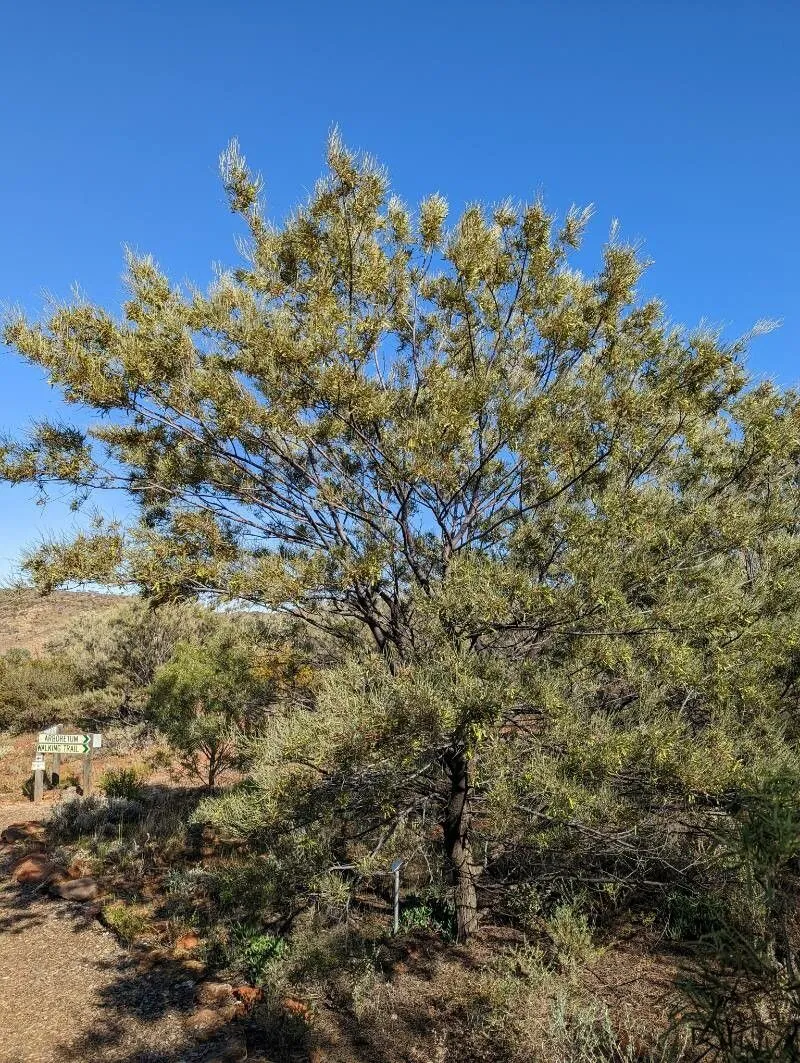
Author: F.Muell. ex Benth.
Bibliography: Linnaea 26: 627 (1855)
Year: 1855
Status: accepted
Rank: species
Genus: Acacia
Vegetable: Unknown
Observations: Australia
The Mulga, scientifically known as Acacia aneura, is a prominent and resilient member of the Fabaceae family. This species was first described in detail and documented in the journal Linnaea in the year 1855, with the botanical authority credited to F. Muell. ex Benth.
Native to the vast, arid regions of Australia, the Mulga tree is exceptionally well-adapted to survive in harsh and challenging environments. As a crucial component of the Australian landscape, especially in the interior and semi-arid zones, Mulga displays a remarkable versatility in terms of its growth and survival strategies.
This hardy tree generally assumes the form of a dense, bushy shrub or small tree, reaching heights of up to 10 meters. Its ability to thrive in areas with low rainfall is partly due to its deep-rooting systems, which efficiently harness moisture from the soil, and its finely divided, feathery foliage, which minimizes water loss. The foliage often appears silver-grey or bluish in color, aiding in reflecting sunlight and reducing transpiration.
The Mulga tree is also well-known for its contribution to the ecosystem. It provides critical habitat and food for a myriad of wildlife species. Its seeds, which are produced in narrow pods, are particularly valued by various bird species and small mammals. Additionally, the tough wood of the Mulga has historically been used by Indigenous Australians for tools and weapons, showcasing its significance to cultural heritage.
Flowering typically occurs after rain, with the Mulga producing bright, golden-yellow flower spikes that not only add a splash of color to the landscape but also attract a range of pollinators, further emphasizing its ecological importance.
In summary, Acacia aneura, the Mulga, stands as a testament to nature’s ingenuity, showcasing an array of adaptations that enable it to flourish in some of the most unforgiving terrains. Its ecological, cultural, and environmental significance underscores its role within the Australian bushland, representing both beauty and resilience.
Eng: mulga
En: Mulga, Mulga tree
Ca: Mulga
Zh: 無脈相思樹
Et: Mulga akaatsia
Fi: Keihäsakasia, Keihäsakaasia
De: Mulga, Mulga-Akazie, Mulga-Baum, Mulgabusch
Pl: Mulga
Taken Aug 9, 2022 by Nickisht (cc-by-sa)
Taken Aug 9, 2022 by Nickisht (cc-by-sa)
Taken Aug 9, 2022 by Nickisht (cc-by-sa)
Taken Aug 9, 2022 by Nickisht (cc-by-sa)
© copyright of the Board of Trustees of the Royal Botanic Gardens, Kew.
© copyright of the Board of Trustees of the Royal Botanic Gardens, Kew.
© copyright of the Board of Trustees of the Royal Botanic Gardens, Kew.
Family: Myrtaceae Author: (F.Muell.) K.D.Hill & L.A.S.Johnson Bibliography: Telopea 6: 402 (1995) Year: 1995 Status:…
Family: Rubiaceae Author: Pierre ex A.Froehner Bibliography: Notizbl. Bot. Gart. Berlin-Dahlem 1: 237 (1897) Year:…
Family: Sapindaceae Author: Koidz. Bibliography: J. Coll. Sci. Imp. Univ. Tokyo 32(1): 38 (1911) Year:…
Family: Asteraceae Author: A.Gray Bibliography: Pacif. Railr. Rep.: 107 (1857) Year: 1857 Status: accepted Rank:…
Family: Fabaceae Author: Medik. Bibliography: Vorles. Churpfälz. Phys.-Ökon. Ges. 2: 398 (1787) Year: 1787 Status:…
Family: Aspleniaceae Author: (Cav.) Alston Bibliography: Bull. Misc. Inform. Kew 1932: 309 (1932) Year: 1932…